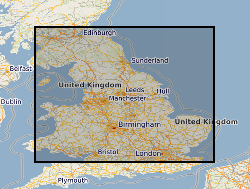Geopackage
Type of resources
Topics
Keywords
Contact for the resource
Provided by
Years
Formats
Representation types
Update frequencies
Resolution
-
Data comprise modelled flood extents for the Kampala district produced by simulating rainfall events over a 5m Digital Elevation Model (DEM) using a 2D finite-volume hydrodynamic model. The DEM was obtained from Makerere University and rainfall events were sampled across a range of depths and durations (for 20, 40, 60, 80 and 100 mm of rainfall over 1, 3 and 6 hours using flood depth thresholds of 0.1, 0.2 and 0.3 mm). The effects of infiltration were included within green areas based on spatial data obtained from Makerere University. Maximum depths were converted into extents using various thresholds. Full details about this dataset can be found at https://doi.org/10.5285/e53dea2e-cb25-4f0f-b5f9-937eecf15aff
-
The data describe vegetation outlines and tree tops above 1m in height as polylines and points. Data have been processed from a digital terrain model (DTM) and digital surface model (DSM), converted from raw LiDAR data. The LiDAR dataset was acquired for Cornwall and Devon (all the land west of Exmouth) during the months of July and August 2013. The data were created as part of the Tellus South West project. Full details about this dataset can be found at https://doi.org/10.5285/78dba959-989b-43d4-b4da-efd2506e0c8e
-
The dataset is the lake polygons from the UK Lakes Portal (https://eip.ceh.ac.uk/apps/lakes/), originally based on OS PANORAMA but this dataset includes data from a number of sources. It has a basic set of attributes including the water body ID (WBID) as well as the computed area and perimeter of each lake. The WBID is commonly used across research institutions and is the same ID as used on the UK Lakes Portal, where more information can be found on each lake in this dataset. This is v3.6, which follows the same versioning as the underlying database. Although the database has seen the majority of the changes since version 1, the polygons have also been changed and improved over that time, mostly fixing issues with lake outlines, but also some new sites being added. Full details about this dataset can be found at https://doi.org/10.5285/b6b92ce3-dcd7-4f0b-8e43-e937ddf1d4eb
-

This dataset provides the first map and synthesis of the temperature of Britain's coalfields. It was created to support low-temperature heat recovery, cooling and storage schemes using mine water in abandoned workings. This baseline spatial mapping and synthesis of coalfield temperatures offers significant benefit to those planning, designing and regulating heat recovery and storage in Britain's abandoned coalfields. The data has been developed jointly by the Coal Authority and the British Geological Survey. It is delivered as a hexgrid representing mine water blocks, identifying equilibrium mine temperatures at 10 depth intervals (100m > 1000m) and pumped mine temperatures at 6 depth intervals (100m > 600m).
-
This dataset contains 10km summarised occurrence data for terrestrial mammals as mapped in the Atlas of Mammal of Great Britain and Northern Ireland published by the Mammal Society in 2020. For each species 10km grid squares were categorised based on whether the species was recorded in that square only the current atlas time period (2000-2016), only the previous atlas time period (1960-1992) or in both time periods. The dataset contains data for all species mapped in the atlas, with the exception of cetaceans which are not included in the dataset. Full details about this dataset can be found at https://doi.org/10.5285/ab61349e-c055-477c-9872-22a4f7cc2473
-
[THIS DATASET HAS BEEN WITHDRAWN]. This dataset contains 10km summarised occurrence data for terrestrial mammals as mapped in the Atlas of Mammal of Great Britain and Northern Ireland published by the Mammal Society in 2020. For each species 10km grid squares were categorised based on whether the species was recorded in that square only the current atlas time period (2000-2016), only the previous atlas time period (1960-1992) or in both time periods. The dataset contains data for all species mapped in the atlas, with the exception of cetaceans which are not included in the dataset. Full details about this dataset can be found at https://doi.org/10.5285/422adbc3-306e-437a-9fe1-c7b53a374f87
-
This dataset contains Land Cover/Land Use (LCLU) maps for Sindhudurg, Shivamogga and Wayanad, India. LCLU products are state-of-the-art statically stable and area weighted accuracy assessed products. The LCLU product was generated for Kyasanur Forest Disease (KFD), a Zoonotic disease. KFD is an “ecotonal” disease. Diverse forest-plantation mosaics, zone moist evergreen forest and plantation, and low coverage of dry deciduous forest will cause higher risks for KFD. Our LCLU product aimed to separate diverse forest types and plantation and we achieved high accuracy (>90%). The study covers Sindhudurg, Shivamogga, and Wayanad Western Ghats district which belong to Indian state Maharashtra, Karnataka, and Kerala respectively. Full details about this dataset can be found at https://doi.org/10.5285/cacb66de-aea0-41d5-97b3-9eacd4683aaf
 NERC Data Catalogue Service
NERC Data Catalogue Service